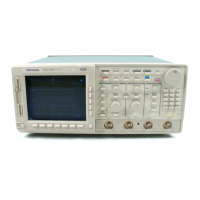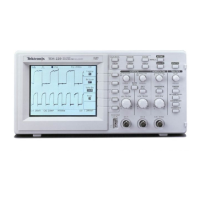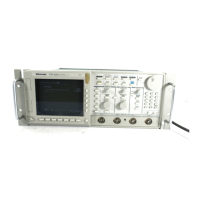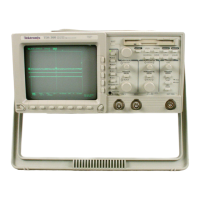Measuring Waveforms
3–158
TDS 500D, TDS 600B, & TDS 700D User Manual
The TDS Oscilloscopes allow you to adjust a relative time delay for each
channel. This feature lets you align the signals to compensate for the fact that
signals may come in from cables of differing lengths.
The oscilloscope applies deskew values after it completes each acquisition;
therefore, the deskew values do not affect logic triggering. Also, deskew has no
affect on XY display format.
To set a channel/probe deskew, do the following steps:
Press VERTICAL MENU ➞ Deskew (main).
Then use the general purpose knob or the keypad to set the deskew time. You
can also eliminate any deskew setting by pressing Set to 0 S (side).
The TDS Oscilloscope lets you compensate the probe, based on the channel it is
connected to, to improve the gain and offset accuracy of the probe. By executing
Probe Cal on a channel with its probe installed, you can optimize the oscillo-
scope capability to make accurate measurements using that channel and probe.
Run a Probe Cal anytime you wish to ensure that the measurements you make
are made with the most accuracy possible. You should also run a Probe Cal if
you have changed to a different probe since the last Probe Cal was performed.
Some Probes Cannot Be Compensated. Some types of probes can be gain
compensated, some can be offset compensated, and some can be compensated
for both. Some probes cannot be compensated at all. Note the following
restrictions:
The oscilloscope cannot compensate probes that have an attenuation factor of
greater than 20X. If you attempt to compensate such a probe you will get an
error message.
The oscilloscope cannot compensate probes that have gain and/or offset
errors that are too great (2% gain and/or 50 mV offset). If these errors
are within specified limits for your probe, you may want to use another
probe. If they are not within specification, have your probe checked by
service personnel.
Channel/Probe Deskew
Probe Cal

